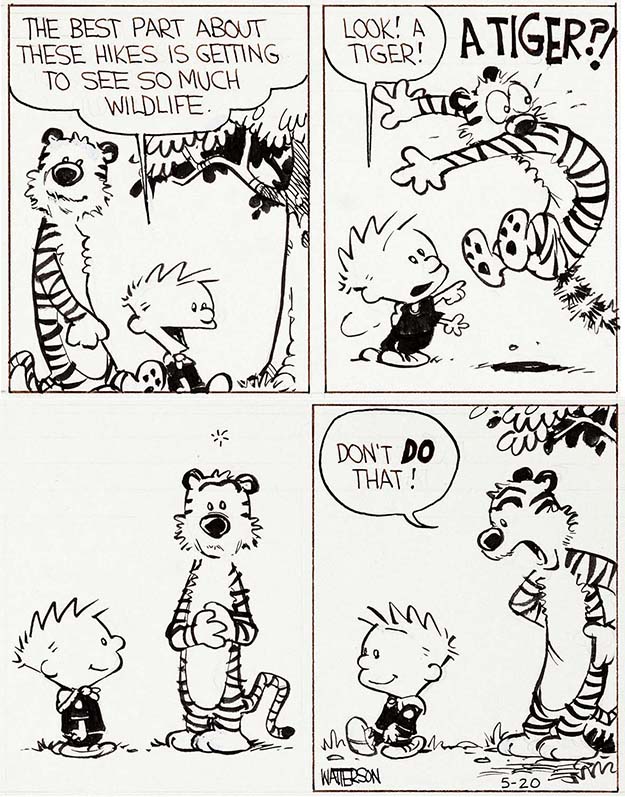This “Calvin and Hobbes” comic strip by Bill Watterson features the two beloved characters, Calvin and Hobbes, in a delightful moment of playful exploration and humor. The strip’s charm lies in its simplicity and the endearing dynamic between the characters, making it a classic example of Watterson’s skill in capturing the essence of childhood imagination and friendship.
The comic strip unfolds in four panels, each contributing to the narrative and building up the humor. In the first panel, we see Calvin and Hobbes walking through the woods, with Calvin expressing his excitement about the possibility of seeing wildlife. His enthusiasm is palpable, and it’s clear that he is in a playful mood. This sets the stage for the ensuing interaction between the two characters. The second panel is where the humor begins to unfold. Calvin, in his characteristic exuberance, points out a tiger, startling Hobbes. The irony here is immediately apparent to the reader—Hobbes himself is a tiger. This visual irony is a hallmark of Watterson’s work, where the mundane and the fantastical often collide in amusing ways. The juxtaposition of Calvin’s excitement and Hobbes’ surprise creates a comedic moment that is both unexpected and delightful. In the third panel, Hobbes is visibly startled, with wide eyes and a shocked expression, while Calvin smiles mischievously. The contrast between the two characters’ reactions adds to the humor. Calvin’s smile indicates that he is aware of the irony and is reveling in the moment, while Hobbes’ reaction shows that he has been caught off guard. This panel captures the playful dynamic between the two characters, where Calvin often takes on the role of the mischievous instigator, and Hobbes, though usually more composed, finds himself reacting to Calvin’s antics. The final panel brings the interaction to a humorous conclusion. Hobbes, now annoyed, tells Calvin not to do that again, while Calvin continues to smile, clearly pleased with himself. This resolution not only reinforces the playful nature of their relationship but also highlights the affection and camaraderie that exists between them. Despite Hobbes’ annoyance, there is an underlying sense of fondness and understanding that characterizes their friendship.
Pause and Continue
Watterson’s use of visual and textual elements in this strip is masterful. The dialogue between Calvin and Hobbes is succinct yet effective in conveying their personalities and the humor of the situation. Calvin’s lines are simple but loaded with playful irony, while Hobbes’ responses capture his initial surprise and subsequent annoyance. The text complements the visuals, enhancing the comedic effect and providing insight into the characters’ thoughts and emotions. The visual elements, particularly the characters’ expressions and body language, play a crucial role in the comic strip. Calvin’s cheerful expressions and eager pointing contrast with Hobbes’ wide-eyed surprise and eventual frustration. These visual cues enhance the humor and provide a deeper understanding of the characters’ dynamic. Additionally, the setting of the woods serves as a natural backdrop, emphasizing the theme of exploration and the innocence of childhood adventures. The comic strip also employs symbolic codes that add layers of meaning to the humor. The most notable example is Hobbes as a tiger. The irony of a tiger being startled by the mention of a tiger is a subtle yet effective way to engage the reader and elicit a laugh. This type of humor, which relies on the reader’s awareness of the characters’ unique identities, is a signature element of Watterson’s work and adds depth to the comic strip.
The interplay between text and image is another key aspect of this comic strip’s effectiveness. The humor arises from the combination of Calvin’s playful commentary and Hobbes’ visual reactions. This interaction between textual and visual elements creates a cohesive narrative that is both engaging and entertaining. Watterson’s ability to balance these elements is a testament to his skill as a cartoonist and storyteller. In terms of audience and purpose, this “Calvin and Hobbes” comic strip is intended for a general audience, including both children and adults. The humor is accessible and relatable, making it enjoyable for readers of all ages. The strip aims to entertain while also capturing the essence of childhood imagination and friendship. Through the playful interactions between Calvin and Hobbes, Watterson invites readers to relive their own childhood memories and experiences. The use of humor in this comic strip is particularly noteworthy. Watterson’s humor is often situational and character-driven, relying on the personalities and dynamics of Calvin and Hobbes to create comedic moments. In this strip, the humor is derived from the situational irony of Hobbes being startled by the mention of a tiger and Calvin’s mischievous delight in the situation. This type of humor is light-hearted and endearing, making it a timeless and enjoyable read.
In conclusion, this “Calvin and Hobbes” comic strip exemplifies Bill Watterson’s talent for creating humorous and heartwarming moments through the interactions of his beloved characters. The combination of visual and textual elements, situational irony, and the playful dynamic between Calvin and Hobbes results in a delightful comic strip that resonates with readers of all ages. Through this simple yet effective narrative, Watterson captures the essence of childhood imagination and friendship, leaving a lasting impression on his audience.
The analysis is apt for both SL and HL students alike. If you are HL, add more nuances to this analysis.

